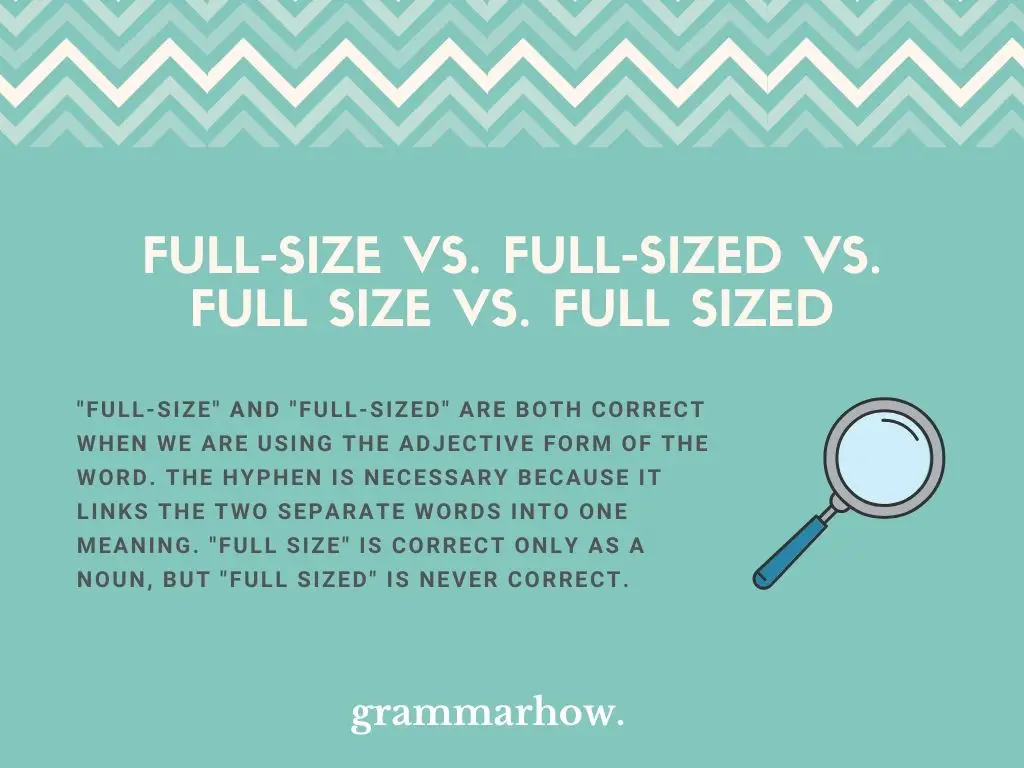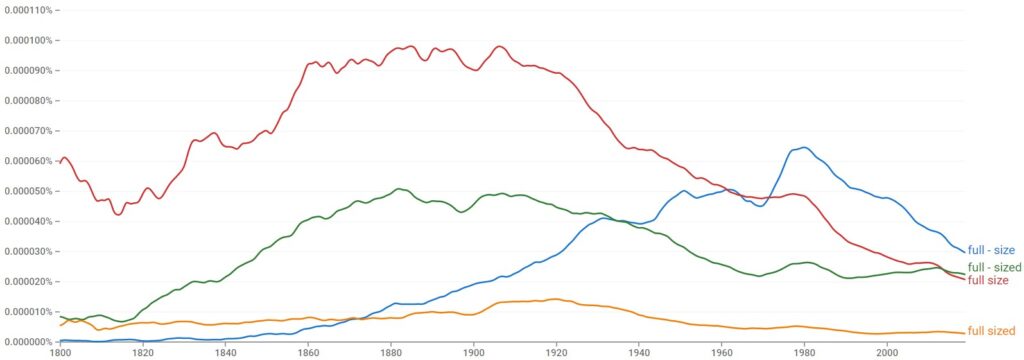There’s a lot to talk about when looking at “full-size” and “full-sized.” This article will cover both one or two words and the hyphenated forms you might use. By the end of this, you’ll have a better understanding of each one.
Full-size vs. Full-sized vs. Full size vs. Full sized
“Full-size” and “full-sized” are both correct when we are using the adjective form of the word. The hyphen is necessary because it links the two separate words into one meaning. “Full size” is correct only as a noun, but “full sized” is never correct.

According to Google Ngram Viewer, “full-size” is the most popular choice of the three. However, there isn’t much between it and “full size” and “full-sized.” As you can see, all three words are correct. However, “full sized” is not (as it is barely used on the graph).

In The Cambridge Dictionary and The Oxford Dictionary, “full-size” and “full-sized” are both defined clearly as adjectives. Both dictionaries define “full-sized” as an adjective and refer to “full-size” as an alternative that can be used.
While neither dictionary refers to “full size,” it is still a phrase that is possible to use. However, since it uses “full” and “size” separately, a combined definition of the phrase is unnecessary.
Full size
“Full size” is grammatically correct when you use it as a noun or phrase. We use it to talk about something having the “full size” that it was expected to have. It cannot be written in this form when used as an adjective because the hyphen would be required.
Therefore, if we tried to write it in the following way:
- The full size board meeting
It would be incorrect. “Board meeting” is a noun, but “full size” cannot modify it unless it is hyphenated.
However, if you want to see how “full size” works, you can refer to these examples:
- I have not seen it reach its full size yet, but I expect it to happen soon.
- This is not the full size! I will keep working until I’ve gotten it there.
- What is the full size expected to be on this one?
- When will my dog grow to its full size? He seems so little!
Full-size
“Full-size” is correct when used as an adjective. We can use it to modify another noun in a sentence. The hyphen is required because the two words have different meanings. We need to group them to show that they are modifying the same word in the same way.
According to AP Stylebook guidelines, it’s important to hyphenate any adjective that’s made of more than one word. We use the hyphen as a linker in such cases to show that both words have the same effect on whatever noun comes after it.
Check out these examples if you don’t get it yet:
- I would like to play with the full-size model whenever you have it in stock.
- The full-size diagram was much larger than I thought it was.
- Have you ever seen the full-size Mona Lisa painting? It’s way smaller than I thought.
- The full-size pocket watch doesn’t actually fit in my pocket!
Full sized
“Full sized” is grammatically incorrect. The only time we can use “full” and “sized” together is when we modify another noun. However, since a hyphen is required to do such a thing, keeping the two words separated is incorrect. You must not do this in any case.
Rather than just telling you it’s incorrect, we thought we could provide some examples to show you what we mean:
- Correct: The full-sized model that they presented was much more impressive than I thought.
- Incorrect: I have not seen the full sized version yet, but I’m sure I’ll see it soon.
- Correct: What is the full-sized magazine cover going to be this week?
- Incorrect: None of this full-sized stuff is of any value to me!
Full-sized
“Full-sized” is correct and is synonymous with “full-size.” We can use either variation (with or without the “d”) to mean the same thing. Both are adjectives that can modify another noun because the hyphen allows us to group the two words without problems.
Again, the AP Stylebook is the one that teaches us to use hyphens when adjectives are made of more than one word.
Here are some more examples to help you:
- Have you seen the full-sized painting yet? It’s glorious.
- The full-sized version is not ready for publication. Please be patient.
- I would like a full-sized cover uncovering the truth of that masked menace.
- We have got to go full-sized with this one! Otherwise, no one will believe us!

Martin holds a Master’s degree in Finance and International Business. He has six years of experience in professional communication with clients, executives, and colleagues. Furthermore, he has teaching experience from Aarhus University. Martin has been featured as an expert in communication and teaching on Forbes and Shopify. Read more about Martin here.

